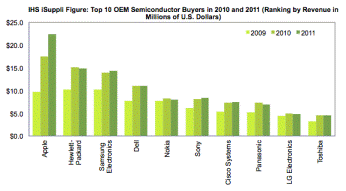


图片来源: IHS iSuppli
|
周三,HIS iSuppli发布报告,证实了此前多数专家早已假定的情况:苹果公司已超过惠普公司和三星公司,成为所谓的原始设备制造商(OEMs)中全球最大的半导体消费者。 据分析师Wenlie Ye的分析,2010年,苹果公司对存储芯片的需求增长了79.6%,并且仍在持续增长。 iSuppli就这种现象产生的原因所作的一番阐释读起来像是直接从斯蒂夫•乔布斯的脚本中抽出来的一页:(引用如下) 尽管苹果公司和惠普公司在计算机领域已经竞争多年,但细查两家公司在半导体方面的开支就知道,这是两家截然不同的公司。 准确的说,苹果公司是无线设备制造商,而不是计算机制造商。它2010年半导体预算中约61%花在了iPhone和iPad这类无线产品上。相比之下,惠普公司2010年半导体支出中的82%都用到了计算机类产品上,如台式机、笔记本和服务器等。 这个消息对苹果公司来说是一大利好:2010年,智能手机和平板电脑市场大幅增长,远超计算机细分市场。2010年,智能手机出货量增长62%,由于苹果公司iPad的上市,平板电脑出货量更是猛增超过900%。 相比之下,2010年全球PC出货量仅微幅增长14.2%。 苹果公司在硬件销售方面的优势在于其设备本身和媒体生态系统——每种苹果产品都通过iTunes/iOS相连接,并能与其他各种苹果产品协同工作。如此一来,苹果操作系统的忠实用户每多买一台苹果设备,都能获得更大的价值,因此这些用户就不再愿意离开苹果的领地。 换言之,通过统一的操作系统,苹果公司充分利用了每台设备,带动其他设备的销售。设备销量上升之后,苹果采购的半导体也随之增多。 相比而言,传统的PC行业不太重视创建操作系统。用户也许这次购买的是惠普PC,但如果他觉得再买一台惠普电脑价值不大或毫无价值可言的话,一旦下次遇到更优惠的价格,他就有可能转而购买戴尔的PC。 译者:清远 |
A report issued Wednesday by IHS iSuppli confirmed what most experts already assumed was true: Apple (AAPL) has overtaken Hewlett-Packard (HPQ) and Samsung to become the world's largest consumer of semiconductors among so-called original equipment manufacturers (OEMs). According to analyst Wenlie Ye, Apple's appetite for memory chips grew 79.6% in 2010 and is still growing. iSuppli's explanation for how this came to be reads like a page out of Steve Jobs' playbook: (I quote) Although Apple and Hewlett-Packard have been rivals in the computer space for many years, an examination of their respective semiconductor expenditures shows that the two companies are fundamentally different. Apple is more a wireless devices maker than a computer maker. The company spent approximately 61 percent of its semiconductor budget in 2010 on wireless products such as iPhones and iPads. In contrast, 82 percent of Hewlett-Packard's 2010 semiconductor spending was dedicated to computer products like desktops, notebooks and servers. This worked to Apple's benefit, with the smart phone and tablet markets massively outgrowing the computer segment in 2010. Smart phone shipments in 2010 rose 62 percent, while tablets exploded by more than 900 percent, driven by the introduction of Apple's iPad. In contrast, global PC shipments grew a relatively weak 14.2 percent in 2010. Apple strength in hardware sales lies in its device and media ecosystem—every Apple product is connected through iTunes/iOS and is synergetic with all other Apple products. As a result, committed users of the Apple ecosystem derive more value from each additional Apple device they buy, and users have little interest in leaving the Apple realm. In other words, through a common ecosystem, Apple leverages each device to sell other devices. Rising device sales to consumers then leads to increased semiconductor purchasing by Apple. In comparison, the traditional PC business does not put heavy emphasis on the creation of an ecosystem. A buyer that once purchased a Hewlett-Packard PC would just as likely purchase a Dell PC next if the price was better, given that there is little or no value in purchasing another Hewlett-Packard. |
相关稿件
最新文章





